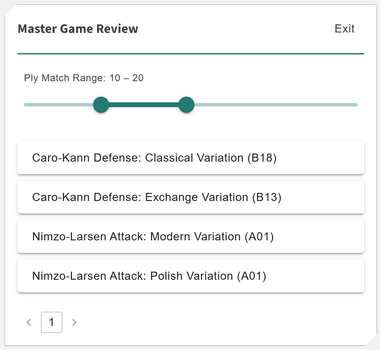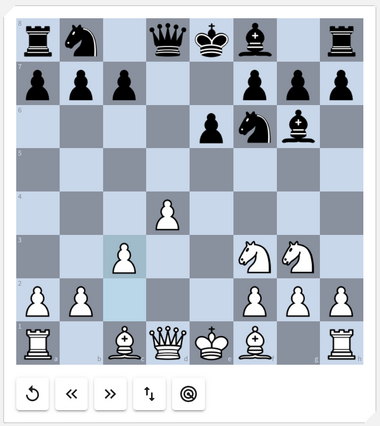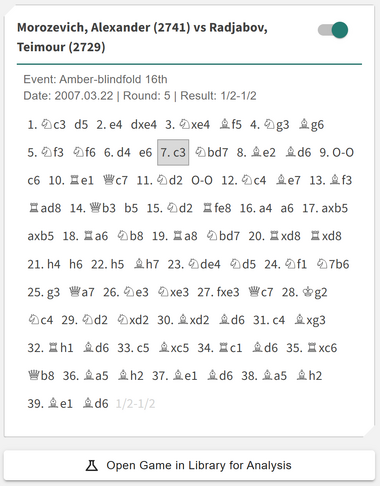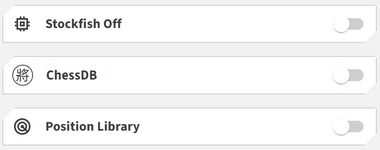Master Game Review: Difference between revisions
More actions
HollowLeaf (talk | contribs) |
HollowLeaf (talk | contribs) |
||
| (3 intermediate revisions by the same user not shown) | |||
| Line 19: | Line 19: | ||
<ul style="list-style:none; padding-left:1.5em; margin:0;"> <li style="text-indent:-1.1em; padding-left:1.1em;"> <span style="display:inline-block; width:0.9em; text-align:center; font-weight:bold;">◦</span> Browse your repertoires in a paginated list for convenient selection </li> <li style="text-indent:-1.1em; padding-left:1.1em;"> <span style="display:inline-block; width:0.9em; text-align:center; font-weight:bold;">◦</span> Load a random master game corresponding to your chosen repertoire </li> <li style="text-indent:-1.1em; padding-left:1.1em;"> <span style="display:inline-block; width:0.9em; text-align:center; font-weight:bold;">◦</span> Adjust the <b>ply range</b> (half-move depth) to control how closely the selected games match your positions </li> </ul> | <ul style="list-style:none; padding-left:1.5em; margin:0;"> <li style="text-indent:-1.1em; padding-left:1.1em;"> <span style="display:inline-block; width:0.9em; text-align:center; font-weight:bold;">◦</span> Browse your repertoires in a paginated list for convenient selection </li> <li style="text-indent:-1.1em; padding-left:1.1em;"> <span style="display:inline-block; width:0.9em; text-align:center; font-weight:bold;">◦</span> Load a random master game corresponding to your chosen repertoire </li> <li style="text-indent:-1.1em; padding-left:1.1em;"> <span style="display:inline-block; width:0.9em; text-align:center; font-weight:bold;">◦</span> Adjust the <b>ply range</b> (half-move depth) to control how closely the selected games match your positions </li> </ul> | ||
{{Notice|Personal Note|I use the Master Game Review to explore how elite players handle my repertoire — especially my <b>Caro-Kann</b> lines. | |||
I use the Master Game Review to explore how elite players handle my repertoire — especially my <b>Caro-Kann</b> lines. | It’s a powerful way to connect my preparation with real-world games, helping me understand not only the theory but also the plans and ideas that arise from it.}} | ||
It’s a powerful way to connect my preparation with real-world games, helping me understand not only the theory but also the plans and ideas that arise from it. | |||
== Chessboard Card == | == Chessboard Card == | ||
| Line 30: | Line 29: | ||
<ul style="list-style:none; padding-left:1.5em; margin:0;"> <li style="text-indent:-1.1em; padding-left:1.1em;"> <span style="display:inline-block; width:0.9em; text-align:center; font-weight:bold;">◦</span> <b>Back:</b> Return to the previous move in the game sequence </li> <li style="text-indent:-1.1em; padding-left:1.1em;"> <span style="display:inline-block; width:0.9em; text-align:center; font-weight:bold;">◦</span> <b>Next:</b> Advance to the next move in the game sequence </li> <li style="text-indent:-1.1em; padding-left:1.1em;"> <span style="display:inline-block; width:0.9em; text-align:center; font-weight:bold;">◦</span> <b>Reset:</b> Return to the starting position of the game </li> <li style="text-indent:-1.1em; padding-left:1.1em;"> <span style="display:inline-block; width:0.9em; text-align:center; font-weight:bold;">◦</span> <b>Flip Board:</b> Change the board orientation to view from the opposite side </li> <li style="text-indent:-1.1em; padding-left:1.1em;"> <span style="display:inline-block; width:0.9em; text-align:center; font-weight:bold;">◦</span> <b>Save Position:</b> Save the current position for later reference or analysis </li> </ul> | <ul style="list-style:none; padding-left:1.5em; margin:0;"> <li style="text-indent:-1.1em; padding-left:1.1em;"> <span style="display:inline-block; width:0.9em; text-align:center; font-weight:bold;">◦</span> <b>Back:</b> Return to the previous move in the game sequence </li> <li style="text-indent:-1.1em; padding-left:1.1em;"> <span style="display:inline-block; width:0.9em; text-align:center; font-weight:bold;">◦</span> <b>Next:</b> Advance to the next move in the game sequence </li> <li style="text-indent:-1.1em; padding-left:1.1em;"> <span style="display:inline-block; width:0.9em; text-align:center; font-weight:bold;">◦</span> <b>Reset:</b> Return to the starting position of the game </li> <li style="text-indent:-1.1em; padding-left:1.1em;"> <span style="display:inline-block; width:0.9em; text-align:center; font-weight:bold;">◦</span> <b>Flip Board:</b> Change the board orientation to view from the opposite side </li> <li style="text-indent:-1.1em; padding-left:1.1em;"> <span style="display:inline-block; width:0.9em; text-align:center; font-weight:bold;">◦</span> <b>Save Position:</b> Save the current position for later reference or analysis </li> </ul> | ||
== Moves Card == | == Moves Card == | ||
| Line 39: | Line 34: | ||
The '''Moves Card''' provides the full move list of the selected master game. | The '''Moves Card''' provides the full move list of the selected master game. | ||
It | It also displays detailed game metadata for clear context and reference: | ||
<ul style="list-style:none; padding-left:1.5em; margin:0;"> <li style="text-indent:-1.1em; padding-left:1.1em;"> <span style="display:inline-block; width:0.9em; text-align:center; font-weight:bold;">◦</span> White player name </li> <li style="text-indent:-1.1em; padding-left:1.1em;"> <span style="display:inline-block; width:0.9em; text-align:center; font-weight:bold;">◦</span> White player Elo rating </li> <li style="text-indent:-1.1em; padding-left:1.1em;"> <span style="display:inline-block; width:0.9em; text-align:center; font-weight:bold;">◦</span> Black player name </li> <li style="text-indent:-1.1em; padding-left:1.1em;"> <span style="display:inline-block; width:0.9em; text-align:center; font-weight:bold;">◦</span> Black player Elo rating </li> <li style="text-indent:-1.1em; padding-left:1.1em;"> <span style="display:inline-block; width:0.9em; text-align:center; font-weight:bold;">◦</span> Event name </li> <li style="text-indent:-1.1em; padding-left:1.1em;"> <span style="display:inline-block; width:0.9em; text-align:center; font-weight:bold;">◦</span> Game date </li> <li style="text-indent:-1.1em; padding-left:1.1em;"> <span style="display:inline-block; width:0.9em; text-align:center; font-weight:bold;">◦</span> Game result </li> </ul> | |||
You can navigate through the full game PGN by clicking on individual moves to jump directly to that position on the board. | |||
Below the move list, you’ll find an <b>Add to Library</b> button, allowing you to store the game in your personal Library for deeper analysis and annotation. | Below the move list, you’ll find an <b>Add to Library</b> button, allowing you to store the game in your personal Library for deeper analysis and annotation. | ||
== Analytics Card == | == Analytics Card == | ||
| Line 52: | Line 50: | ||
Each card helps you analyze the selected master game from a different perspective — theoretical, statistical, and personal repertoire alignment. | Each card helps you analyze the selected master game from a different perspective — theoretical, statistical, and personal repertoire alignment. | ||
{{DocNav | |||
| prev = Spaced Trainer | |||
| prev_label = Spaced Trainer | |||
| next = Candidate Move Trainer | |||
| next_label = Candidate Move Trainer | |||
}} | |||
Latest revision as of 09:51, 15 October 2025
Location: Trainer > Master Game Review
The Master Game Review selects a random master game that passes through positions from your repertoire, giving you the chance to study how strong players handled the same lines. By reviewing these games, you can see practical applications of your repertoire, learn typical plans, and deepen your understanding of the openings you play.
This allows you to:
- + Discover how top players approach your repertoire’s key positions
- + Learn typical middlegame plans and strategies emerging from your opening lines
- + Reinforce your repertoire knowledge by seeing it applied in real high-level games
Controls

The Controls card shows a paginated list of your repertoires. When you select one, it searches for a random Master Game from the Lichess Masters Database that passes through positions within that repertoire. This gives you an instant opportunity to explore how strong players navigated similar structures and themes.
This allows you to:
- ◦ Browse your repertoires in a paginated list for convenient selection
- ◦ Load a random master game corresponding to your chosen repertoire
- ◦ Adjust the ply range (half-move depth) to control how closely the selected games match your positions
Chessboard Card

The Chessboard Card displays the selected master game, allowing you to play through it move by move. There are five control buttons are available for interacting with the game:
- ◦ Back: Return to the previous move in the game sequence
- ◦ Next: Advance to the next move in the game sequence
- ◦ Reset: Return to the starting position of the game
- ◦ Flip Board: Change the board orientation to view from the opposite side
- ◦ Save Position: Save the current position for later reference or analysis
Moves Card

The Moves Card provides the full move list of the selected master game. It also displays detailed game metadata for clear context and reference:
- ◦ White player name
- ◦ White player Elo rating
- ◦ Black player name
- ◦ Black player Elo rating
- ◦ Event name
- ◦ Game date
- ◦ Game result
You can navigate through the full game PGN by clicking on individual moves to jump directly to that position on the board.
Below the move list, you’ll find an Add to Library button, allowing you to store the game in your personal Library for deeper analysis and annotation.
Analytics Card

The Analytics Card provides three analysis tools for deeper exploration of each position:
- ◦ Stockfish: Provides engine evaluation and suggested continuations
- ◦ ChessDB: Displays statistical performance and frequency of master-level moves
- ◦ Position Library: Shows how the position relates to your saved repertoire lines
Each card helps you analyze the selected master game from a different perspective — theoretical, statistical, and personal repertoire alignment.
